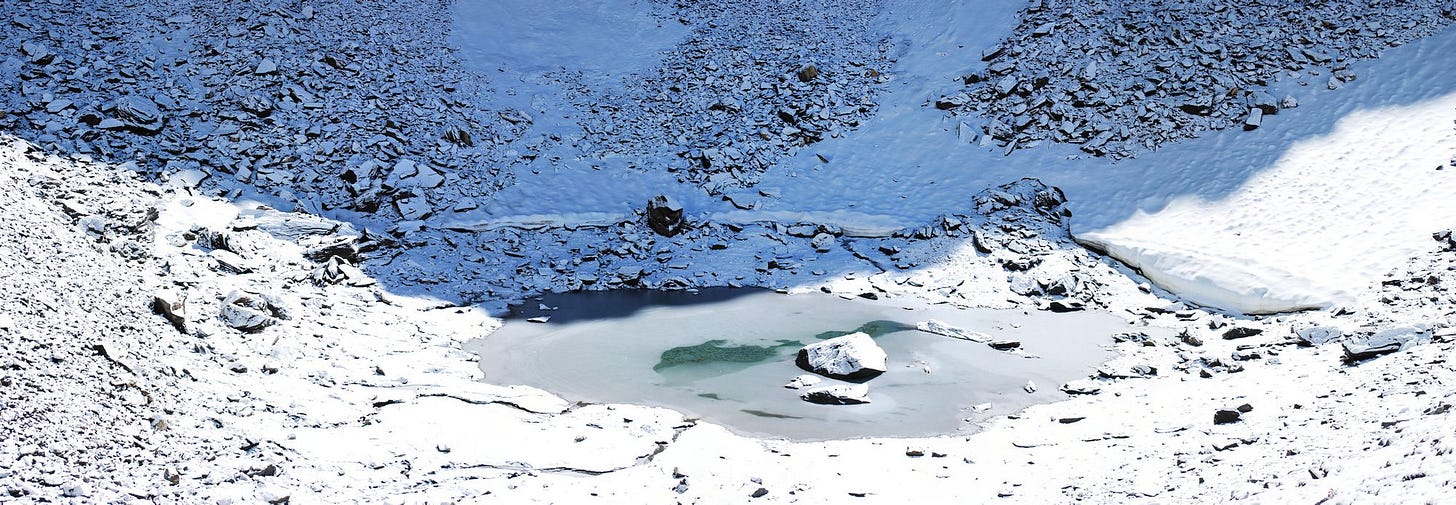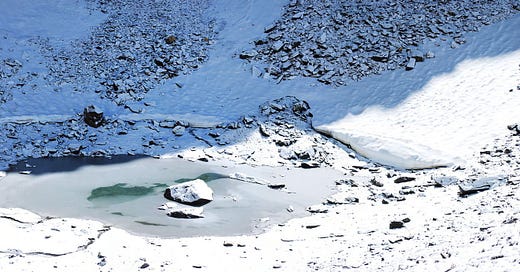Geneticists work to understand how skeletons wound up in a mysterious Himalayan lake
Reviewing new work that reveals migrants from several historic periods in the skeletons surrounding this lake in India.

Yesterday a fascinating story came out in Nature Communications about the skeletons of Roopkund Lake, in northern India: “Ancient DNA from the skeletons of Roopkund Lake reveals Mediterranean migrants in India”. The research was authored by Éadaoin Harney and coworkers. Some background about the site is provided by the introduction of the study:
Roopkund Lake is a small body of water (~40 m in diameter) that is colloquially referred to as Skeleton Lake due to the remains of several hundred ancient humans scattered around its shores (Fig. 1). Little is known about the origin of these skeletons, as they have never been subjected to systematic anthropological or archaeological scrutiny, in part due to the disturbed nature of the site, which is frequently affected by rockslides, and which is often visited by local pilgrims and hikers who have manipulated the skeletons and removed many of the artifacts.
The Atlantic has a nice article by Rachel Gutman that reviews the research: “The Mystery of ‘Skeleton Lake’ Gets Deeper”.
Since a forest ranger stumbled across the ghostly scene during World War II, explanations for why hundreds of people died there have abounded. These unfortunates were invading Japanese soldiers; they were an Indian army returning from war; they were a king and his party of dancers, struck down by a righteous deity. A few years ago, a group of archaeologists suggested, after inspecting the bones and dating the carbon within, that the dead were travelers caught in a lethal hailstorm around the ninth century.
It turns out that the skeletons accumulated over at least three different episodes, and they reflect entirely different groups of people, one from as far away as the Eastern Mediterranean. This deepens the historical mystery: how did groups of people from three different places and times end up dead in this one place?
What I really like about the study is the multidisciplinary approach relying upon ancient DNA, stable isotopes, and radiocarbon to develop lines of evidence about the origin of the individuals. I wish that these had been combined with a deeper analysis of the skeletal biology of the individuals, including what can be said about their anatomical features, age, sex, and health status.
The study does include some information from a report on the physical anthropology of the skeletons, placed into a supplementary note (Supplementary Note 2). The note explains the connection between the work and a National Geographic documentary that was produced in 2004.
The following section is an edited version of an unpublished report generated before genetic data were available by co-author Prof. Subhash Walimbe. The goal of our edits is to synthesize the anthropological discussions included in that report with the genetic findings. Newly added statements dealing directly with the genetic results are shown in italics. Some of the content of the original reports was used as part of the script of a National Geographic television documentary that was made describing the Roopkund Lake Site, so there are similarities between parts of the text that follows and that script.
One reason why I’m interested in the skeletal information is that this case raises important questions about archaeological sites more broadly. Here’s a case where the context of the skeletal remains led scientists naturally to assume that they represented a single event or group. Now we know that the remains come from different groups who lived more than a thousand years apart, and some of whom came from very far away.
As scientists, we’re conditioned to assume that such coincidences don’t happen. Skeletal remains in one place with an ostensibly similar depositional situation should represent similar individuals. Yet more and more sites are revealing two situations that challenge the usual assumptions:
Cemetery distributions that actually represent diverse people who have migrated to a single location, integrating (to varied extents) into a single society.
Multiple depositional situations that occur within the same landscape or space, sometimes guided by geographic or geological conditions, but representing entirely different groups of people.
The first situation has become a widespread subject in stable isotope biology, as strontium and other stable isotopes have revealed individuals who originated far from the cemeteries where they ended up. The second situation is also being revealed more and more by technology as skeletal remains and genetic data show big differences between individuals from single archaeological sites. The recent analysis of the skulls from Apidima—one very Neanderthal-like in morphology, the other much more modern in what is preserved—is a great example of this.
Coincidences of body deposition from different times and cultures are cropping up. With a large enough record, of course, coincidences are inevitable. But my feeling is that they are turning out to be more common than we have assumed, and that means we need to apply extra critical analysis to many archaeological sites.
So a close study of the skeletal biology is very much in order. The supplementary note mentions a difference in “robusticity” among the skulls. Quantifying whether this actually reflects the population differences in the genetics, whether there are health differences that might have been noticed between groups, and whether there are other clues of different populations would be very worthwhile.
Because other cases are out there, and we’ve likely missed them by assuming that bodies found together must sample variation within a single group.
One more note on this study: This analysis included DNA sampling of 71 individuals, 35 based on whole-genome approaches. This is a huge study in terms of the history of ancient DNA analysis, but today it is a moderate sample size for an analysis of new data. We’ve come to the point where dozens of samples of genome-wide data are within the bounds of a single paper in a speciality journal, to answer a fairly specialized historical question. That’s a great thing from the standpoint of replicability of studies and building a more powerful understanding of the past. But it’s a concern if this is a standard that other studies of the past will be forced to meet. It is not always appropriate to require such large sample sizes, even if a skeletal sample numbers that many individuals.
In this case, the sample size of skeletal material was large, the skeletons themselves are in an unsecured situation where they are subject to looting, and the connection to possible descendant communities was previously unknown. It would be valuable to use this paper for a case study of how confident we can be of conclusions at varied sample sizes—possibly in combination with deeper skeletal analyses.



